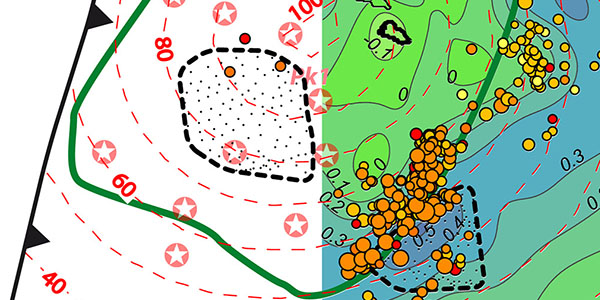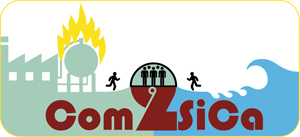Flagship Research Projects
{imageshow sl=23 sc=6 w=800 h=400 /}
S5 - Synchronous Slow Slip & Seismic Swarm
- Details

Slow slip events (SSE) are transient processes releasing stress at faults without significant earthquake. Their discovery about two decades ago in subduction zones demonstrates a complex dynamics of the megathrust controlled by spatially variable friction at the plate interface. While deep SSEs occurring downdip of highly locked areas have been extensively studied, other subduction zones highlight another transient process where slip occurs at the same depths as large earthquakes and is synchronous to intense micro-seismicity. We refer to this type of transient as S5 for Synchronous Slow Slip & Seismic Swarm, which is the focus of our proposal.
MARACAS - MARine terraces along the northern Andean Coast as a proxy for seismic hazard ASsessment - ANR JC 2018
- Details
Large subduction earthquakes occur just below densely populated coastal areas and are therefore the source of very high risks for these regions. Among them, South America is one of the most seriously threatened. Its western coast is formed all along by the longest and most active known subduction zone. This project focuses on the northern section of this subduction zone from Northern Ecuador to Northern Peru.
Anticipating the location of the next ruptures and their magnitude is of commensurate importance to properly anticipate the risks and hence to protect the populations. Until recently, the critical questions posed to the scientific community of ‘when, where, and how large will the next earthquakes be?’ have been addressed using characteristics of large past earthquakes as a proxy for the possible future events. In this project, we propose a complementary approach to modern strain and stress monitoring of active tectonic zones.
Com2SiCa - Understanding and Simulation of Human Behaviors in areas affected by disasters: from analysis to policy making
- Details
 While the past forty years have been affected by a significant increase in the number of disasters, they have also proved the intricacy of the events when numerous causes mingled together (physical, biological, technological and human causes). Those trends should not reverse over the coming years, for numerous risk factors remain: climate change, geopolitical strains, risks associated with technological development and the needs of human societies, population growth and poverty, environment degradation and urban pressure, etc. (URD, 2010). Modern societies, whatever their stages of development, are still inadequately prepared to cope with the intricacy and suddenness of disaster events, and become resilient. Populations often do not know how they should react or take action to protect themselves against a threat or danger (CEPRI, 2013). If some behaviors prove to be appropriate, some other ones, unfortunately more numerous (Boyd, 1981; ISI, 2012), turn out to be inappropriate (stunning, escape towards the danger zone, etc.) or clearly insane (curiosity, goods protection, etc.), as compared to the behaviors expected by the operational stakeholders (Quarantelli, 2008) and that are recommended in prevention tools. This partial misconception is not confined solely to populations and policy-makers; it also relates to the difficulties encountered by the research community in identifying the range of behavior patterns actually triggered in the face of a disaster (Crocq, 1994), their sequence, dynamics, and interdependence (Provitolo et al. 2015).
While the past forty years have been affected by a significant increase in the number of disasters, they have also proved the intricacy of the events when numerous causes mingled together (physical, biological, technological and human causes). Those trends should not reverse over the coming years, for numerous risk factors remain: climate change, geopolitical strains, risks associated with technological development and the needs of human societies, population growth and poverty, environment degradation and urban pressure, etc. (URD, 2010). Modern societies, whatever their stages of development, are still inadequately prepared to cope with the intricacy and suddenness of disaster events, and become resilient. Populations often do not know how they should react or take action to protect themselves against a threat or danger (CEPRI, 2013). If some behaviors prove to be appropriate, some other ones, unfortunately more numerous (Boyd, 1981; ISI, 2012), turn out to be inappropriate (stunning, escape towards the danger zone, etc.) or clearly insane (curiosity, goods protection, etc.), as compared to the behaviors expected by the operational stakeholders (Quarantelli, 2008) and that are recommended in prevention tools. This partial misconception is not confined solely to populations and policy-makers; it also relates to the difficulties encountered by the research community in identifying the range of behavior patterns actually triggered in the face of a disaster (Crocq, 1994), their sequence, dynamics, and interdependence (Provitolo et al. 2015).
- FAULTS R GEMS - Properties of FAULTS, a key to Realistic Generic Earthquake Modeling and hazard Simulation
- INPOP and the Search of the Planet P9
- REMAKE - Seismic Risk in Ecuador: Mitigation, Anticipation and Knowledge of Earthquakes
- SISMED - Seismic Imaging inveStigation in MEDiterranean Sea for deep seismogenic faults
- E-POST - The Early POSTseismic Deformation
- HYDROSEIS - Role of fluids and fault HYDROmechanics on SEISmic rupture
- OBSIVA - Virtual Seismological Observatory for the Lesser Antilles Subduction
- TO-EOS - The Tohoku-Oki Earthquake from Earth to Oceans and Space
UMR Géoazur
Campus Azur du CNRS
250 rue Albert Einstein
- CS 10269 - F 06905 SOPHIA ANTIPOLIS Cedex
+33 (0)483 618 500





